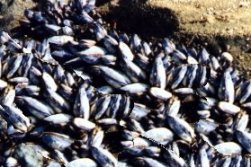 There are three types of marine mussels found around our coasts, One being the horse
mussel sometimes called the fan shell.
There are three types of marine mussels found around our coasts, One being the horse
mussel sometimes called the fan shell.
The other two being more common are the Blue and Green lipped mussels.
The Blue (Mytilus edulis) is dark blue in colour and a white colour at the pointed end.
The size they grow to would be around 4 to 9 cm, and inhabit the rocky coastline
abundantly from the top of the South Island to the bottom, they are much more scarce in
the north. They grow in large clumps or masses on the rocky surfaces.
Many of these particular shell fish grow naturally, and can be found around rocky areas along the coast line. But also many are now being grown and harvisted in farms around the country, this is known as aquaculture, and also known as marine farming
The Green (Perna canaliclus) I believe to be more common than the Blue live in the warmer waters, and though may be also found all around the coasts they are much more abundant in the North.
The Green lipped mussels also attach themselves to rocks and other solid
underwater structures ( but they may also colonise the sea floor with the aid of threads
attached to sand grains and other shell fragments).
These mussels tend to grow an average of 12 to 15 cm but may be found larger on occasions.
They are bright green as juveniles tending to darken as they mature and sometimes have yellow to reddish streaks over the shells.
The spawning cycle for the mussel starts about the month of April each year, just before the water temperatures begin to climb.
When the conditions are right, the male and female mussels spawn releasing their eggs and sperm into the water where the eggs are immediately fertilized. Within 24 hours The fertilized eggs become swimming larvae and remain so for around a time span of three weeks, at which time they go through another change where they develop their shell and other organs. At this point they are ready to settle on something solid.
As the mussel goes through this final change from a swimming larvae to its shelled form it is about (1/3 of a millimetre) long, it develops a foot. On the base of this foot there is a gland which secretes a very strong cement to whatever it attaches itself to.
Once attached (to whatever), the mussel pulls its foot back creating a thread of the cement which hardens on contact with the sea water. The mussel will continue to put out these threads until it is securely attached to some structure. At that point it has pretty much found its home for life, although it can use its foot to attach to something nearby and still move a little bit. Once settled the mussels begin to feed.
Mussels require an abundant supply of relitive clear contaminant free water.
Mussels feed on different kinds of phytoplankton growing in the top layers of waters in which the mussels live.
Mussels are very efficient filter feeders, with adults able to filter about 15 gallons of water per day. They filter up to 60% of the plankton out of the water which they take in. After about three weeks of growing, the small mussels become visible, this is normally in the first few weeks of May.
As the summer progresses, the mussels grow rapidly and by August they are about 2 centimeters in length. After about one year the mussels will be a size most enjoyable to harvest and eat.